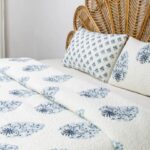1. Introduction to Machine Quilts
- Definition of machine quilts
- Evolution of quilting techniques
- Importance in modern crafting and design
2. Types of Quilting Machines
- Domestic sewing machines
- Longarm quilting machines
- Midarm quilting machines
- Embroidery machines for quilting
3. Advantages of Machine Quilting
- Speed and efficiency
- Enhanced design possibilities
- Accessibility for beginners
4. Key Components of a Quilting Machine
- Needles and thread options
- Presser foot functions
- Feed dogs and quilting frames
5. Essential Tools and Supplies
- Fabric types and selection
- Batting materials
- Cutting tools: rotary cutters, mats, and rulers
(Step 1: 1-5)
1. Introduction to Machine Quilts
Machine quilting is a revolutionary approach that combines traditional quilting artistry with the precision and speed of modern machinery. Unlike hand quilting, which relies on manual stitching, machine quilts use sewing machines to stitch intricate designs into layers of fabric and batting, resulting in durable and visually stunning quilts.
The evolution of quilting dates back centuries, when it was primarily a labor-intensive craft used for utility. Over time, quilting transitioned into a celebrated art form, with machine quilting becoming a pivotal force in the crafting industry. Today, machine quilts are admired for their versatility, whether in creating family heirlooms, fashionable decor, or practical bedding.
Why has machine quilting gained such widespread appeal? It democratizes quilting by making it more accessible and efficient. It empowers hobbyists and professionals alike to push creative boundaries, from detailed patterns to personalized designs. Quilters no longer need to spend months on a single piece; they can now achieve professional-quality results in a fraction of the time.
2. Types of Quilting Machines
Machine quilting wouldn’t be possible without the innovation of specialized equipment. Depending on your skill level, budget, and project scope, you can choose from several types of quilting machines.
Domestic Sewing Machines
Most beginners start with domestic sewing machines, which are versatile and cost-effective. These machines can handle basic quilting tasks like piecing and straight-line stitching but may have limitations in handling large quilts or intricate free-motion designs.
Longarm Quilting Machines
Longarm quilting machines are the crown jewels of quilting equipment. These machines are designed for large projects and professional-grade work. With an extended frame and a motorized system, they allow quilters to complete expansive quilts with incredible precision. Their capability to handle dense quilting patterns and layered fabrics makes them ideal for high-demand quilters.
Midarm Quilting Machines
Midarm quilting machines offer a middle ground between domestic and longarm machines. They provide more workspace and advanced features than domestic machines but are more affordable and less cumbersome than longarm options.
Embroidery Machines for Quilting
For quilters who love intricate designs, embroidery machines are an excellent choice. These machines combine quilting with embroidery, allowing you to add intricate motifs, monograms, and embellishments to your quilts.
3. Advantages of Machine Quilting
Why is machine quilting a game-changer? The answer lies in its remarkable benefits.
1. Speed and Efficiency
Traditional hand quilting requires months, sometimes years, to complete a single quilt. Machine quilting reduces this timeframe significantly. With automated features and high-speed stitching, you can finish a project in days or even hours.
2. Enhanced Design Possibilities
Modern quilting machines come equipped with features like free-motion quilting, programmable stitch patterns, and computerized designs. This opens up endless possibilities for creativity. From simple straight lines to elaborate floral motifs, machine quilting can transform fabric into a masterpiece.
3. Accessibility for Beginners
While hand quilting requires significant skill and practice, machine quilting allows beginners to produce professional-looking results from the start. Many quilting machines offer user-friendly interfaces, tutorials, and pre-set patterns that simplify the learning curve.
4. Key Components of a Quilting Machine
Understanding the anatomy of a quilting machine is crucial for producing high-quality quilts.
Needles and Thread Options
Choosing the right needle and thread is vital. Quilting needles are sharper and sturdier than standard sewing needles, designed to pierce through multiple layers without breaking. Threads should be strong yet flexible; cotton and polyester are popular choices.
Presser Foot Functions
A quilting machine’s presser foot holds the fabric layers steady while stitching. Specialized quilting feet, like walking feet and free-motion feet, enable even stitching and precise control over patterns.
Feed Dogs and Quilting Frames
Feed dogs are small metal ridges that move fabric through the machine. Lowering the feed dogs allows for free-motion quilting, giving you control over stitch direction and speed. Quilting frames, meanwhile, keep the fabric taut and aligned, ensuring consistency in large projects.
5. Essential Tools and Supplies
No quilting setup is complete without the right tools and materials.
Fabric Types and Selection
Quilts are all about layers. Selecting high-quality fabrics ensures durability and aesthetic appeal. Cotton is a favorite for its breathability and ease of use, while blends offer additional texture and resilience.
Batting Materials
Batting forms the quilt’s insulating middle layer. Options range from cotton and polyester to wool and bamboo. Cotton batting is soft and natural, while polyester is lightweight and affordable, making it ideal for beginners.
Cutting Tools: Rotary Cutters, Mats, and Rulers
Precision is key in quilting. Rotary cutters provide clean, straight edges while self-healing mats protect your workspace. Rulers, especially transparent ones with grid markings, are essential for measuring and cutting fabric pieces accurately.

